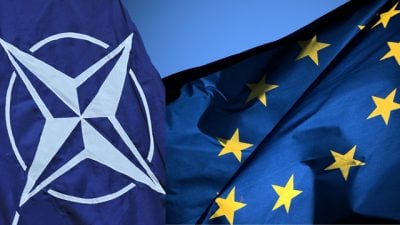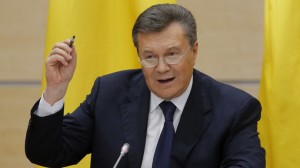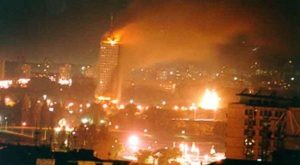The EU and NATO Remain Closely Linked on the Most Important Issues. Nuclear Weapons “Sharing Policy” directed against Russia

Of the European Union’s 28 member states, it reveals much that 22 of these nations belong to NATO, the Pentagon-run military organization.
What is striking also is that, in the post-Soviet Union years, EU and NATO enlargement has moved eastwards almost in synchronization. Political figures in Brussels have committed the error in failing to detach crucial EU policies from that of Washington, leading to rising tensions with Russia.
The Kremlin is a significant trading partner of the EU, but commerce between Brussels and Moscow has declined continuously since 2012; largely because of European actions such as supporting the overthrow of a government in the Ukraine, bordering Russia, and instituting a Western-backed leader (Petro Poroshenko).
The EU thereafter consented to Washington’s orders in implementing sanctions on Russia, following Vladimir Putin‘s incorporation of the Crimea in March 2014 – a region that, like the Ukraine, has a generations-long history with Russia, and whose residents for the majority comprise of ethnic Russians.
Moscow’s takeover of the Crimea came as a response to the US-engineered ousting of Viktor Yanukovych in Kiev the month before, in February 2014. Yanukovych’s toppling enraged the Russian government, who have understandable concerns relating to what occurs along their frontiers. The Kremlin has reacted further with their own financial measures, costing the EU many billions of euro.
Over the previous generation in particular, NATO’s enduring existence has been a major concern for those in Russia, and with good reason. For example the NATO bombardment of Serbia, during the spring of 1999, was a pointed provocation of Russia, though this was barely recognized. The NATO attack came at a time when Russia as a nation was weak, still recovering from Soviet dissolution in late 1991. Serbian-Russian relations trace centuries into the past, and they remain as allies to present times.
Starting on 24 March 1999, NATO’s assault on Serbia was imposed as a demonstration of American power and credibility, in a territory that once lay comfortably within the USSR’s “backyard”. The Bill Clinton administration had moreover decided to initiate military action against Serbia, due to Belgrade’s disregarding of US demands by not accepting Washington-designed neoliberal programs. Serbia composed part of the last corner of Europe still a neoliberal free zone.
Western audiences were spared these cold facts. Propaganda prevailed eulogizing NATO’s “humanitarian intervention” in Serbia and surrounding Yugoslavia. The NATO barrage had nothing to do with concerns about human rights, or the plight of Kosovar Albanians, and everything to do with maintaining US prestige, power and strategic superiority.
NATO would commit war crimes during its almost 80 day assault on Yugoslavia – including killing hundreds of civilians through “surgical” air strikes, along with other acts such as blowing up the Chinese embassy in Belgrade and taking out the country’s public broadcaster, Radio Television of Serbia (RTS).
Unsurprisingly, the Chinese were irked by the bombing of their embassy which they believed to be deliberate. Three Chinese citizens lost their lives, provoking fury in Beijing. China’s ambassador to the UN, Qin Huasun, said of the bombing,
“NATO’s barbarian act is a violation of the UN Charter”.
NATO claimed they had mistaken the embassy for a “munitions storage facility”, adding to Chinese suspicions.
Of the 13 NATO states that officially partook in the bombing of Yugoslavia, nine of them consisted of EU members. The EU was therefore complicit in attacking Yugoslavia. Just over a decade later, 10 EU countries under the NATO banner participated in the intervention in Libya – which, as with the case of Serbia, left both countries in a far worse condition than they were prior to the NATO attacks.
One of the key reasons that NATO was formed in 1949, was so as to prevent Europe from pursuing a path independent of American foreign policy. In that regard, it has worked.
Over the past seven decades, European leaders have displayed a happy subservience in the face of overwhelming US financial and military power.
NATO and the EU are inextricably tied concerning one of the most critical issues: Nuclear weapons. The EU is headquartered in Brussels, capital of Belgium, which is a “founding member” of NATO. Belgium is also a de facto nuclear power. The Belgian state has been home to US nuclear weapons for almost 56 years, since November 1963, the same month that John F. Kennedy was assassinated. America’s nuclear cache was secreted into Belgium without notifying the Belgian parliament; nor indeed the country’s populace.
Situated a mere 60 miles north-east of Brussels are at least 20 American B-61 nuclear bombs, stored in vaults at Kleine Brogel Air Base. This installation jointly hosts squadrons of the US and Belgian air forces, ensuring that the important orders originate from Washington.
Belgian pilots come into contact with US nuclear weapons in Kleine Brogel, and are familiar with their design. The B-61 bombs are in addition “to be carried and delivered by the Belgian Air Force’s dwindling inventory of F-16 fighter jets”, according to the experienced American analyst and author, William M. Arkin.
A B-61 bomb contains a high yield of between 340 to 400 kilotons, reaching 20 times more powerful than the atomic weapon which destroyed much of Nagasaki in south-west Japan. Even half of that explosive force, 170-200 kilotons, would inflict multiple times the destruction in comparison to the “Fat Man” dropped on Nagasaki, and which held within it about 20 kilotons of explosive power.
Meanwhile, Belgium is also a top priority target for terrorist atrocities, as seen over preceding years. One can presume that an ISIS fighter would desire very much indeed to pilfer a nuclear bomb, and do untold damage with it. The possibility is very small, as special expertise and advanced technological capabilities are surely required to fire a nuclear weapon, but the chances are not zero.
Nor is the possibility zero that an unforeseen accident could occur with a nuclear weapon aboard an F-16 jet, such as at Kleine Brogel.
Incidents have materialized with F-16 aircraft in past years (and other jet types) that are cause for concern; like the fatal crash with a Greek F-16 jet that occurred in fellow NATO country Spain, during January 2015, that killed 11 people – at the time the plane had been involved in “a NATO exercise”; and earlier this summer when an F-16 “packed with weapons” lost control and “slammed into a warehouse” in California leaving “a gaping hole in the roof”. It was not reported that the jet in question was nuclear-armed, but any impact with such a weapon around the aircraft’s undercarriage could result in a partial or even full nuclear explosion.
In nuclear state Israel last October, an F-16 jet “almost collided with another aircraft and several ground crew members” when “the aircraft lost its braking capability”.
Regarding Belgium, the presence of nuclear weapons in the country “is neither confirmed nor denied” by the state’s politicians. Belgian governments are seemingly unable to confirm or deny what is perhaps the biggest immediate threat facing their country: a nuclear conflagration.
One can be sure the Kremlin is aware that Belgium constitutes in effect a nuclear power. As a result, Belgium may rank as high priority scope in Russian nuclear war planning. The B-61 bombs near Brussels are placed there of course with Russia in mind.
Germany, the EU’s dominant nation, is also a NATO power and de facto nuclear state. The now dissolved West Germany acceded to NATO in May 1955. Two months before, in March 1955, West Germany began stationing US nuclear weapons on its territory in preparation for NATO’s nuclear “sharing policy”.
Nuclear weapons have now been present on German soil for 64 years. Germany is holding 20 US B-61 bombs at Büchel Air Base in the country’s far-west, where separate squadrons of the German and US air forces are quartered. German security has been significantly compromised. Büchel Air Base is within comfortable driving distance of large western German cities like Cologne, Frankfurt and Stuttgart.

Demonstration for Gen Roger Brady, USAF, then-Commander of USAFE, of the disarming procedure of a B61 nuclear bomb on a “dummy” weapon shape in an underground Weapons Security and Storage System (WS3) vault at Volkel Air Base. These B61 nuclear weapons are shared by the United States and Germany. (Source: Public Domain)
Chancellor Angela Merkel professes that US militarism is protecting Germany and encompassing regions, when something like the opposite is the case, as these areas have been placed in clear danger. Once more, the Russians have little alternative but to take into account the presence of US nuclear bombs, particularly with NATO having expanded to its borders this century.
EU and NATO “founding member” Italy is home to at least 70 American B-61 bombs in two air bases – Ghedi and Aviano – in the north-east of the country. Both of Italy’s nuclear cargoes are located dangerously close to her biggest cities like Milan, Turin and Venice. Italy has been a de facto nuclear power since April 1957, over five years before the Cuban Missile Crisis.
The Netherlands is yet another EU state, NATO founder and nuclear power in reality. For the past 59 years, the Dutch have held US nuclear weapons on their land, stretching to April 1960. Their US-made B-61 bombs are stored at Volkel Air base in the south, which is positioned well under 100 miles from Amsterdam and Rotterdam, the nation’s two largest cities. As with Belgian governments, their Dutch counterparts “neither confirm nor deny” that foreign-built nuclear weapons are in the country, as they have been for decades.
Turkey remains part of NATO, for now. Relations with Washington are far from harmonious; still, Turkey continues holding 50 US-produced B-61 bombs at Incirlik Air Base situated just five miles from Adana, Turkey’s fifth largest city. The nuclear weapons at Incirlik are positioned less than 200 miles from terrorist-infiltrated Idlib, where fighting rages with Russian-supported Syrian government forces. Turkey has held possession of US nuclear bombs since February 1959, a few weeks after Fidel Castro assumed power in Cuba.
Associations such as NATO “have been a major cause of wars throughout modern history”, as the American historian Gabriel Kolko noted. NATO may well be the most hazardous union of all, due to its standing as a nuclear-armed, heavily militarized organization which – in violation of verbal commitments – enlarged eastwards from 1990 and is now, as stated, resting upon the very boundaries of nuclear superpower Russia.
Altogether, there are presently around 150 US nuclear weapons dotted about in the above EU or NATO countries. That might seem like a sizeable total, yet there were approximately 2,500 American nuclear bombs spread across Europe in 1959. By 1966, that number had doubled to a peak of 5,000, as Europe literally brimmed with US nuclear devices, bolstered by the atomic powers of France and Britain.
Come the late 1970s, there were still over 4,000 US nuclear warheads on European soil. From therein, the numbers steadily declined. Ultimately, however, it does not matter if there are 5,000 or 150 American nuclear bombs in Europe as one explosion, even without retaliation, may be enough to precipitate the nuclear winter phenomenon. The means to deliver nuclear weapons have expanded in technological scope, led by US advancements, ensuring that the risks are heightened.
Since its founding 70 years ago, NATO has if anything destabilized the European continent, by ramping up distrust with Moscow. Respected US diplomats like George Kennan, who had a good understanding of Russia, predicted as much. Kennan was opposed to NATO’s formulation from the beginning, as he foresaw the dangers that lay ahead with an arms race unfolding – as the above-mentioned figures reveal.
The USSR, to be more exact, Russia, was compelled to follow suit in establishing its own organization in 1955 to rival NATO, the Warsaw Pact.
Today, NATO comprises of 29 states while the Warsaw Pact becomes a fading and distant memory. Twelve out of those 29 NATO nations have joined over the past two decades alone. Some of them consist of former Warsaw Pact countries once allied to Russia, which must be galling for Kremlin diplomats to witness.
NATO, that is Washington, has imminent plans to swell its ranks further and newly-named North Macedonia, a tiny Balkan state, is in the process of becoming a NATO vassal. At virtually the same time, North Macedonia has also been touted to join the EU.
Not unreasonably, the Kremlin associates EU membership with that of NATO. For years, Moscow has been alarmed at the Ukraine making moves towards EU membership, eventually paving the way for NATO accession, a most unacceptable outcome for the Russians.
*
Note to readers: please click the share buttons above or below. Forward this article to your email lists. Crosspost on your blog site, internet forums. etc.
Shane Quinn obtained an honors journalism degree. He is interested in writing primarily on foreign affairs, having been inspired by authors like Noam Chomsky. He is a frequent contributor to Global Research.



